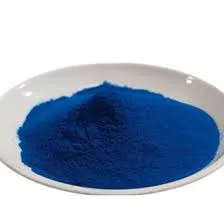Exploring the Benefits and Applications of Synthetic Indigo in Wholesale Markets and Industries
The Wholesale Indigo Synthetic Market Trends and Insights
Indigo, a vibrant shade of blue, has a long and storied history in the world of textiles. Traditionally derived from natural sources such as the indigo plant (Indigofera tinctoria), it has been used for centuries to dye fabrics, most notably denim. However, with the rise of synthetic alternatives, particularly in the wholesale market, the dynamics of indigo production and consumption have seen significant shifts. This article explores the wholesale synthetic indigo market, its benefits, challenges, and future prospects.
Understanding Synthetic Indigo
Synthetic indigo was first developed in the late 19th century as a more stable, cost-effective alternative to natural indigo. The synthetic version is produced through chemical processes that allow for large-scale production without the dependency on agricultural yield or seasonality. This has led to the establishment of synthetic indigo as a dominant force in the textile dyeing industry, particularly for denim manufacturers.
One of the most significant advantages of wholesale synthetic indigo is its consistency. Synthetic dyes provide uniform color across large batches, which is crucial for fabric manufacturers that require exact specifications to meet consumer demands. Additionally, synthetic indigo can be produced in large quantities, helping businesses manage inventory and reduce disruptions caused by fluctuations in natural indigo supply.
The Market Dynamics
The wholesale synthetic indigo market has experienced substantial growth over the past few decades. This is largely attributed to the increasing demand for denim across the globe, with the ready-to-wear clothing industry continuing to flourish. Major fashion brands require reliable and cost-effective materials, making synthetic indigo an appealing choice.
Moreover, as sustainability becomes a priority for consumers and companies alike, synthetic indigo manufacturers have been investing in eco-friendly production methods. Innovations such as waterless dyeing technologies and the use of non-toxic chemicals are being integrated into the production process, making synthetic indigo a more appealing option for environmentally-conscious brands.
wholesale indigo synthetic

Challenges Facing the Market
Despite its advantages, the wholesale synthetic indigo market is not without challenges. One major concern is the environmental impact associated with synthetic dye production. Traditional synthetic dye processes can lead to water pollution if not managed properly, given that many dyes are toxic and can contaminate local waterways. This has led to increased scrutiny and environmental regulations, pushing manufacturers to adopt more sustainable practices.
Market competition is another challenge. As more companies venture into the synthetic dye market, maintaining competitive pricing while meeting quality standards becomes crucial. This competitive landscape forces manufacturers to continuously innovate, which can be a resource-intensive process.
Future Prospects
Looking ahead, the wholesale synthetic indigo market is poised for continued growth. Advances in biotechnology may lead to even more sustainable production methods, such as biosynthetic indigo derived from microbial processes. These innovations could address environmental concerns while meeting market demand.
Furthermore, as ethical fashion gains momentum, brands that prioritize sustainability and transparency in their supply chains are likely to seek out synthetic indigo that meets these standards. This shift could create new opportunities for manufacturers who can effectively illustrate their commitment to environmentally-friendly practices.
In conclusion, the wholesale synthetic indigo market represents a complex interplay of tradition, innovation, and sustainability. As the textile industry evolves, synthetic indigo will remain a crucial player. With a focus on overcoming challenges and embracing sustainable practices, the future of synthetic indigo appears bright, promising a harmonious balance between quality, cost, and environmental stewardship.
-
The Timeless Art of Denim Indigo Dye
NewsJul.01,2025
-
The Rise of Sulfur Dyed Denim
NewsJul.01,2025
-
The Rich Revival of the Best Indigo Dye
NewsJul.01,2025
-
The Enduring Strength of Sulphur Black
NewsJul.01,2025
-
The Ancient Art of Chinese Indigo Dye
NewsJul.01,2025
-
Industry Power of Indigo
NewsJul.01,2025
-
Black Sulfur is Leading the Next Wave
NewsJul.01,2025

Sulphur Black
1.Name: sulphur black; Sulfur Black; Sulphur Black 1;
2.Structure formula:
3.Molecule formula: C6H4N2O5
4.CAS No.: 1326-82-5
5.HS code: 32041911
6.Product specification:Appearance:black phosphorus flakes; black liquid

Bromo Indigo; Vat Bromo-Indigo; C.I.Vat Blue 5
1.Name: Bromo indigo; Vat bromo-indigo; C.I.Vat blue 5;
2.Structure formula:
3.Molecule formula: C16H6Br4N2O2
4.CAS No.: 2475-31-2
5.HS code: 3204151000 6.Major usage and instruction: Be mainly used to dye cotton fabrics.

Indigo Blue Vat Blue
1.Name: indigo blue,vat blue 1,
2.Structure formula:
3.Molecule formula: C16H10N2O2
4.. CAS No.: 482-89-3
5.Molecule weight: 262.62
6.HS code: 3204151000
7.Major usage and instruction: Be mainly used to dye cotton fabrics.

